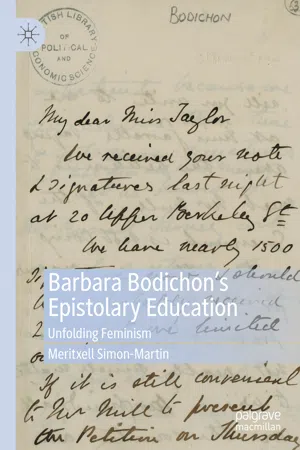On 10 June 2018 tens of thousands of women marched through the streets of Belfast, Cardiff, Edinburgh and London to mark the centenary of women wining the vote. Colourful processions featured hand-made banners, sashes and period costumes made in purple, white and green—the colours of the suffragette movement. The posters showcased a wide array of feminist slogans and claims, ardently advocated in a cheerful atmosphere. The year 2018 commemorated indeed the 1918 Representation of the People Act, which gave women over the age of thirty who met a property qualification the right to vote in local and national elections. The fight for women’s voting rights had started decades before, when in 1866, capitalizing on a Reform Bill being discussed in Parliament, Barbara Leigh Smith Bodichon (1827–1891) stirred up a group of like-minded friends to gather signatures for a petition in favour of the female vote, which was presented in the House of Commons by a sympathetic John Stuart Mill. To make her point, she penned a series of papers. Among them, Reasons for the Enfranchisement of Women was enclosed in the petition for signatures and read at the Manchester Social Science Association conference. Her paper captured the imagination of Lydia Becker (1827–1890), who was to become one of the leading activists of the women’s suffrage movement.1
Bodichon had previously mobilized her political acumen, charismatic personality and economic resources in favour of other feminist claims. She was the mastermind behind the Married Women’s Property Campaign of 1855–1857—traditionally regarded as the beginning of ‘feminism as an organised social movement.’2 Making the most of the public interest aristocratic socialite Caroline Norton had aroused after two decades of pleading for the custody of her children from her abusive husband, Bodichon published in 1854 her first pamphlet, Brief Summary in Plain Language of the Most Important Laws Concerning Women a readable digest of a wordy and lengthy book published by legal expert John Jane Smith Wharton a year before.3 As scholars have outlined, the booklet put forward in a ‘clear,’4 ‘unemotional, indeed rather dull’5 style a ‘concise description’6 of women’s legal disabilities, the tone being deliberately ‘careful and dispassionate’7 so as to ‘emphasize the reasonableness of the case and the solidity of its foundation.’8 The pamphlet attracted the attention of the Law Amendment Society—already discontent with the inefficiency of existing legislation and the confusion between common law and courts of equity. Reaping the benefit of this interest, Bodichon gathered friends around her, including writers Anna Jameson and Mary Howitt, and drew a petition in favour of a legal reform that would permit married women to hold property and have direct access to their own earnings.9 From Bodichon’s London home at 5 Blandford Square, the committee coordinated the collection of 26,000 signatures following the country-wide chain of letters pattern that was to be put into play in subsequent campaigns, including the vote10—connecting London-based activists with Josephine Butler in Liverpool, Ursula Bright in Manchester and Elizabeth Wolstenholme in Cheshire among many others.11 The provisions included in the petition presented in Parliament, which sought to make married women legal entities in their own right, were not fully gained until a series of Married Women’s Property Acts were passed in the 1880s and 1890s.12 But this first effort involved the creation of informal ‘self-consciously’13 feminist networks across the country that resulted in new sympathizers and active supporters. In the words of lifelong friend Bessie Rayner Parkes (1829–1925), ‘people interested in the question were brought into communication in all parts of the kingdom, and the germs of an effective movement were scattered far and wide.’14 For her decisive contribution, Lee Holcombe concludes that Bodichon ‘may indeed be called the real founder of that movement.’15
A positivist persuaded of the unstoppability of progress and man’s capacity to foster it, Bodichon did indeed fight for women’s rights on paper and in action from an early age. Following her father’s steps, she established Portman Hall in 1854—an experimental coeducational and undenominational school in London which, attended by infants from different backgrounds, ruptured with the philanthropic tradition of ‘cater[ing] only for delineated social groups.’16 In the words of early twentieth-century feminist Ray Strachey, it was ‘exceedingly modern,’ where ‘the pupils were taken to museums and picture-galleries, and were taught to think rather than remember, and its unconventional character attracted a great deal of notice.’17
Bodichon published her first articles in the local press when she was twenty-one and established, in collaboration with Parkes, their own magazine in 1858: The English Woman’s Journal , which, being ‘the first feminist journal in Britain,’18 became the ‘official organ of the women’s movement.’19 ‘[R]epresenting a “liberal feminism”, rooted in political individualism and political economy,’20 its aim was to provide a space for the discussion and diffusion of their feminist activities, with employment being ‘the key issue of the periodical’ as well as ‘the necessity of education and training’ for women and their commitment to ‘philanthropic responsibilities.’21 With the help of newly recruited supporters they soon expanded their pursuits in favour of improving the provision of education for girls and women and opening new employment opportunities for them. Jessie Boucherett and Adelaide Proctor set up the Society for Promoting the Employment of Women, where the...
